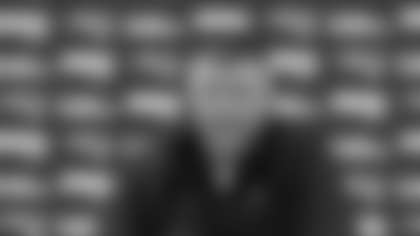The dust has barely settled from the Super Bowl; Maurice Clarett is entering the draft; Drew Henson had his big workout; and now we are days away from the NFL Scouting Combine. Indianapolis will be a city full of draft-eligible players, scouts, coaches, general managers, a few owners, and of course, the agents.
What goes on in Indy is the second real sorting out process of all the available players for the 2004 NFL Draft after the all-star games. This is when opinions are formed, some accurate and some not. When the combine ends on Feb. 23, people will start to whisper, write, and talk about where prospects deserve to be drafted based on the information they uncovered during the testing and interrogating of these athletes.
People still have other means of gathering information over the next two months, but this is a very important time. And as we get farther into the week, we will all hear how critical it is for athletes to compete at the combine from club officials, and conversely, we will hear from draft-eligible players and their representatives that they will work out at another time at another place.
Eli Manning, projected to be the first overall pick in April, said he was working hard down in Florida on his 40-yard-dash techniques, but would not run until March at the New Orleans Saints facility. As a football personality who spent 12-hour days in the RCA Dome, I understand why team officials might want to see him compete, but I also understand the other side of the logic not to compete. As one prominent agent said to me this week when I asked him if his top clients were working out in Indy, he said 'no, and for two big reasons: Domanick Davis and Anquan Boldin'. Both of those young players last year felt they had to do everything at the combine so they participated and they ran slow. Their draft status was damaged in the eyes of club officials with the slow times.
Why take a slow player when you can take a fast player? Maybe because the "slower" player is a better football player? Davis ran a 4.62, which is a bit too slow for an elite running back. Boldin ran an awful 4.72, which is snails pace for a wide receiver. Of course, both players went on to have excellent rookie seasons in the NFL. Davis ran for 1,031 yards and eight touchdowns as the top rookie running back in the league for Houston and Boldin caught 101 passes for 1,377 yards and eight touchdowns. Their football production far outweighed their 40-yard times, but Davis was drafted in the fourth round and Boldin went in the second round.
They lost a significant amount of money on draft day and most agents I spoke with put the initial blame on the 40-yard dash at the combine. Club officials I spoke with say there were other reasons for the draft status. Injuries, lack of information from position changes, fumble problems, were a few of the things I heard when I asked why did they get drafted so low as compared to how they performed. The truth is it's always a combination of things that decisions are based on and it's possible both sides are right.
The more I hear all the statistics people prop up for why they make decisions, the more I'm drawn back to watching more game tapes and interviewing the players to make decisions. Can a guy play the game and does he have the intangibles? Team officials heading to Indianapolis all week have to ask questions on how to re-evaluate their decision-making process. For example, how does a guy like Boldin who ran 4.72 at the combine have a 71-yard touchdown reception in his rookie season? Did his quickness or athletic ability compensate for his 40 time. Did Davis' balance and change-of-direction ability make him a more productive back than Jerome Bettis, Anthony Thomas or Eddie George last year? Or how many great backs ran 4.6?
All I can think about if I were running a personnel department right now is to tell my staff, 'go find the Domanick Davis and Anquan Boldin of this draft.' It's too easy to rank players by position based on measurable testing results that might cause more problems than resolve them. Be careful what you are looking at when players gather in Indy in shorts. That is not football! Be careful during the interview process about asking insignificant questions that players have memorized answers to. I've been tricked by super-prepared players; I've been convinced. I could tell the difference between players after a combine workout.
Club officials will say the combine is only a piece of the puzzle and they might believe that, but between the high draft picks that don't work out in Indy, the number of players who work out poorly and the successful rookies who weren't even invited to the combine, it might be time for some people to take another look at why they are in Indianapolis.
I went back and looked at a number of pre-draft lists from last April and I asked two team officials where they had a few players ranked going into the draft and I asked them what they do in the offseason in the area of self-analysis. Davis ranged from ninth to 14th in the running back population. Boldin was anywhere from eighth to 12th among the receivers. But it didn't stop there. I took a look at the All-Rookie team and a number of rookies who excelled this past season that were drafted no higher than the fourth round to find the common thread as to why they were drafted lower than where they actually performed.
Panthers cornerback Ricky Manning started in the Super Bowl. After he won the starting job, his team went 6-1 on the road. He was drafted in the fourth round and he ran a slow 40 (4.53) at the combine. He ran faster later in the spring but was ranked anywhere between eighth and 12th on most cornerback lists. One college scout admitted his combine 40 time was a factor. Receiver Brandon Lloyd also went in the fourth round to the 49ers. He ran a 4.62 at the combine. He caught 14 passes last season and is positioned to be a starter, but his combine time was a factor. I could go on and on, but the truth is there were eight rookies to receive honors for distinguished play who were second-day picks and there were two outstanding rookie tight ends that weren't even drafted -- Casey Fitzsimmons (Detroit) and Antonio Gates (San Diego).
By no means am I trying to be critical of the combine process. Much information can be gained from the time with the young men. But what I am saying is there is a great opportunity waiting for the people responsible for a team's draft to look at combine results differently and find those special players most teams will be downgrading this week because of a less-than-stellar performance. My coaches and scouts would be sharing nothing with other colleagues from other teams and instead looking for the guys people are starting to make a mistake on.
It was easy to spot Jordan Gross (Panthers, first round) and Eric Steinbach (Bengals, first round) as good players, but go to the combine looking for linemen like Steve Sciullo (Colts, fourth round), Dan Koppen (Patriots, fifth round), David Diehl (Giants, fifth round), Wayne Lucier (Giants, seventh round), Phil Bogle (Chargers, undrafted), Montrae Holland (Saints, fourth round) and study what these fine rookies all had in common. And what they all did not to impress at last year's combine to be drafted so low.
Can you imagine how good your owner would feel right now if you found a reason to take every one of these players just one notch higher than they went? Most of these linemen ran a slow 5.4 in the 40 at the combine except for Koppen, who blazed a 5.28. All of them played in the NFL as rookies. As one of smartest football friends I have in the NFL said to me this week, 'there is a competitive edge to be gained from changing the way I use the results of the combine. I hope after all these years I can try different ways of using the information we gather in Indianapolis'. I couldn't agree more!









































